
William Blake's Illustrations of the Book of Job
Encyclopedia
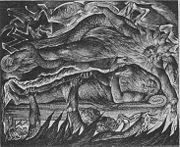
William Blake
William Blake was an English poet, painter, and printmaker. Largely unrecognised during his lifetime, Blake is now considered a seminal figure in the history of both the poetry and visual arts of the Romantic Age...
's Illustrations of the Book of Job primarily refers to a series of twenty-two engraved
Engraving
Engraving is the practice of incising a design on to a hard, usually flat surface, by cutting grooves into it. The result may be a decorated object in itself, as when silver, gold, steel, or glass are engraved, or may provide an intaglio printing plate, of copper or another metal, for printing...
prints (published 1826) by Blake illustrating the biblical Book of Job
Book of Job
The Book of Job , commonly referred to simply as Job, is one of the books of the Hebrew Bible. It relates the story of Job, his trials at the hands of Satan, his discussions with friends on the origins and nature of his suffering, his challenge to God, and finally a response from God. The book is a...
. It also refers to two earlier sets of watercolours by Blake on the same subject (1806 and 1821). The engraved Illustrations are considered to be Blake's greatest masterpieces in the medium of engraving, and were also a rare commercial and critical success for Blake.
Development and printing history
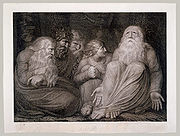
Origins
As early as 1785 Blake had sketched several ink studies of an illustration to Job. In 1793 Blake engraved a composition based upon these drawings, which he offered for sale in the Prospectus to the Public for twelve shillings. This, alongside an engraving of EzekielEzekiel
Ezekiel , "God will strengthen" , is the central protagonist of the Book of Ezekiel in the Hebrew Bible. In Judaism, Christianity and Islam, Ezekiel is acknowledged as a Hebrew prophet...
, are the only extant examples of an intended series of biblical illustrations that were never completed. Blake reworked the Job plate sometime after 1804, but the resulting print was not included in the Illustrations.
Blake's next illustration was the tempera painting Job and his Daughters (1800), commissioned by Thomas Butts (see gallery below). This has similarities to plate 20 of the engraved illustrations, but it is unclear whether the print was directly based upon it.
The watercolours
The engraved illustrations to Job originated as a series of watercolours that Blake painted in 1805-6, also for Butts. These 19 watercolours are referred to as the Butts Set (in the collection of the The Morgan Library & Museum).A second set of watercolors, known as the Linell Set (mostly in the collection of the Fogg Art Museum
Fogg Art Museum
The Fogg Museum, opened to the public in 1896, is the oldest of Harvard University's art museums. The Fogg joins the Busch-Reisinger Museum and the Arthur M. Sackler Museum as part of the Harvard Art Museums....
) was produced in 1821 at the request of John Linell
John Linnell (painter)
John Linnell was an English landscape painter. Linnell was a naturalist and a rival to John Constable. He had a taste for Northern European art of the Renaissance, particularly Albrecht Dürer. He also associated with William Blake, to whom he introduced Samuel Palmer and others of the...
. Linell traced the watercolours from the "Butts set"; these tracings were then colored in by Blake. As a result of this unusual process, the outlines of the Linell set are thicker and the coloring is uniformly darker, with a more restricted palette than the Butts set. Blake also added two new designs to the Linell set, and added copies of these to the Butts set. The two designs added were No.s 17 and 20, The Vision of Christ and Job and His Daughters.
There is also another set of watercolours known as the New Zealand Set. These were initially believed to be from Blake's hand, but their authenticity has been all but refuted by scholars such as Martin Butlin and Bo Lindberg. They were most likely a copy from the engravings by someone in the circle of John Linell, as they have no unique features.
The engravings
In 1823 Linell formally commissioned Blake to engrave plates for printing. Unlike Blake's own productions in relief etching, this, like other commissioned work, was produced using the intaglioIntaglio (printmaking)
Intaglio is a family of printmaking techniques in which the image is incised into a surface, known as the matrix or plate, and the incised line or area holds the ink. Normally, copper or zinc plates are used as a surface, and the incisions are created by etching, engraving, drypoint, aquatint or...
method of engraving. However, Blake rejected the "mixed method" popular among commercial reproductive engravers of his time. The "mixed method" entailed lightly etching
Etching
Etching is the process of using strong acid or mordant to cut into the unprotected parts of a metal surface to create a design in intaglio in the metal...
guidelines into the plate. The image was then engraved by the dot and lozenge method and by stippling. Instead, Blake engraved his illustrations in pure line and without preliminary etching.
The engravings were completed in 1825, and an edition of 315 was produced in 1826. These were the last set of illustrations that Blake would complete. His illustrations of Dante's Divine Comedy were left unfinished upon his death.
The completed engravings differ from Blake's original watercolors mainly in the complex marginal designs that they employ. These comment upon the text with biblical quotes and paraphrases, and also contain images that reinforce the themes of the main illustrations.
After completing the engravings, Blake painted an additional tempera of Satan Smiting Job with Boils in 1826.
Blake's interpretation
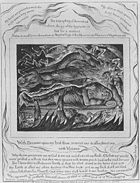
Harold Bloom
Harold Bloom is an American writer and literary critic, and is Sterling Professor of Humanities at Yale University. He is known for his defense of 19th-century Romantic poets, his unique and controversial theories of poetic influence, and his prodigious literary output, particularly for a literary...
has interpreted Blake's most famous lyric, The Tyger
The Tyger
"The Tyger" is a poem by the English poet William Blake. It was published as part of his collection Songs of Experience in 1794 . It is one of Blake's best-known and most analyzed poems...
, as a revision of God's rhetorical questions in the Book of Job concerning Behemoth and Leviathan. Blake also depicted the story of Job throughout his career as an artist. The song of Enion in Night the Second of The Four Zoas
Vala, or The Four Zoas
Vala, or The Four Zoas refers to one of the incompleted prophetic books by English poet William Blake, begun in 1797. The titular main characters of the book are The Four Zoas: , who were created by the fall of Albion in Blake's mythology. It consists of nine books, referred to as "nights"...
also demonstrates that Blake identified with Job.
The God of Job's comforters, who claim that Job's trials are punishment for his sins, is to Blake a false god, equivalent to the demiurge
Demiurge
The demiurge is a concept from the Platonic, Neopythagorean, Middle Platonic, and Neoplatonic schools of philosophy for an artisan-like figure responsible for the fashioning and maintenance of the physical universe. The term was subsequently adopted by the Gnostics...
of the Gnostics
Gnosticism
Gnosticism is a scholarly term for a set of religious beliefs and spiritual practices common to early Christianity, Hellenistic Judaism, Greco-Roman mystery religions, Zoroastrianism , and Neoplatonism.A common characteristic of some of these groups was the teaching that the realisation of Gnosis...
. This was more of a distinction between Elohim
Elohim
Elohim is a grammatically singular or plural noun for "god" or "gods" in both modern and ancient Hebrew language. When used with singular verbs and adjectives elohim is usually singular, "god" or especially, the God. When used with plural verbs and adjectives elohim is usually plural, "gods" or...
(the creator) and Yahweh
Yahweh
Yahweh is the name of God in the Bible, the God of Abraham, Isaac, Jacob, Jews and Christians.The word Yahweh is a modern scholarly convention for the Hebrew , transcribed into Roman letters as YHWH and known as the Tetragrammaton, for which the original pronunciation is unknown...
(the law-giver) than it was any direct influence of Gnosticism.
For Blake, Yahweh was an imposer of laws upon a humanity that could never keep to them—he appears in the 11th illustration as a cloven-hoofed apparition who menaces Job while pointing to the tablets of the covenant
Ten Commandments
The Ten Commandments, also known as the Decalogue , are a set of biblical principles relating to ethics and worship, which play a fundamental role in Judaism and most forms of Christianity. They include instructions to worship only God and to keep the Sabbath, and prohibitions against idolatry,...
. In Blake's mythology he is analogous to "the Accuser of Sin", the spectre
Spectre (Blake)
The Spectre in William Blake's mythology is one aspect of the fourfold nature of the human psyche. It is introduced in Blake's prophetic book Jerusalem:...
, and Urizen
Urizen
In the complex mythology of William Blake, Urizen is the embodiment of conventional reason and law. He is usually depicted as a bearded old man; he sometimes bears architect's tools, to create and constrain the universe; or nets, with which he ensnares people in webs of law and conventional culture...
. This particular print was based upon Blake's earlier monotype, Elohim Creating Adam.

Use of Symbols
Blake used symbolism extensively in the illustrations; most notable is the use of right and left limbs in the figures. The right limb represents the spiritual and the good; the left, the material and evil. In plate six, SatanSatan
Satan , "the opposer", is the title of various entities, both human and divine, who challenge the faith of humans in the Hebrew Bible...
smites Job with boils using his left hand, and in plate 15 God indicates Behemoth and Leviathan with his left hand. Contrarily, God banishes Satan with his right hand in plate sixteen and speaks to Job from the whirlwind in plate fourteen with his right foot extended forward. Some scholars, however, have asserted that this systematic interpretation fails to account for inconsistencies in such symbolism and is excessively subjective.
Artistic influences
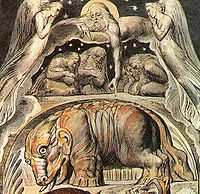
Albrecht Dürer
Albrecht Dürer was a German painter, printmaker, engraver, mathematician, and theorist from Nuremberg. His prints established his reputation across Europe when he was still in his twenties, and he has been conventionally regarded as the greatest artist of the Northern Renaissance ever since...
. The depiction of Behemoth in plate 15 of the engravings is believed to have been influenced by Dürer's Rhinoceros
Dürer's Rhinoceros
Dürer's Rhinoceros is the name commonly given to a woodcut executed by German painter and printmaker Albrecht Dürer in 1515. The image was based on a written description and brief sketch by an unknown artist of an Indian rhinoceros that had arrived in Lisbon earlier that year. Dürer never saw the...
.
In his Public Address (possibly from 1810), Blake also indicates "Marc Antonio" (Marcantonio Raimondi
Marcantonio Raimondi
Marcantonio Raimondi, also simply Marcantonio, was an Italian engraver, known for being the first important printmaker whose body of work consists mainly of prints copying paintings. He is therefore a key figure in the rise of the reproductive print...
), as an artist who inspired his linear technique of engraving. "Julio Romano" (Giulio Romano
Giulio Romano
Giulio Romano was an Italian painter and architect. A pupil of Raphael, his stylistic deviations from high Renaissance classicism help define the 16th-century style known as Mannerism...
), Raphael
Raphael
Raffaello Sanzio da Urbino , better known simply as Raphael, was an Italian painter and architect of the High Renaissance. His work is admired for its clarity of form and ease of composition and for its visual achievement of the Neoplatonic ideal of human grandeur...
, and Michelangelo
Michelangelo
Michelangelo di Lodovico Buonarroti Simoni , commonly known as Michelangelo, was an Italian Renaissance painter, sculptor, architect, poet, and engineer who exerted an unparalleled influence on the development of Western art...
are also mentioned by Blake in this address.
Critical reception and legacy
Of the edition of 315, only 20 copies of the illustrations were sold in Blake's lifetime, mostly to people within Blake's immediate circleAncients (art group)
The Ancients , were a group of English artists who were brought together by their attraction to archaism in art and admiration for the work of William Blake. The core members of the Ancients were Samuel Palmer, George Richmond, Edward Calvert...
(such as Samuel Palmer
Samuel Palmer
Samuel Palmer was a British landscape painter, etcher and printmaker. He was also a prolific writer. Palmer was a key figure in Romanticism in Britain and produced visionary pastoral paintings.-Early life:...
). However, the Illustrations brought Blake an unprecedented degree of recognition. The Royal Academy
Royal Academy
The Royal Academy of Arts is an art institution based in Burlington House on Piccadilly, London. The Royal Academy of Arts has a unique position in being an independent, privately funded institution led by eminent artists and architects whose purpose is to promote the creation, enjoyment and...
and the King's Library
King's Library
The King's Library was one of the most important collections of books and pamphlets of the Age of Enlightenment. Assembled by George III, this scholarly library of over 65,000 volumes was subsequently given to the British nation by George IV. It was housed in a specially built gallery in the...
each bought a copy; the former also awarded Blake ₤25. Such notables as John Constable
John Constable
John Constable was an English Romantic painter. Born in Suffolk, he is known principally for his landscape paintings of Dedham Vale, the area surrounding his home—now known as "Constable Country"—which he invested with an intensity of affection...
and Lady Caroline Lamb
Lady Caroline Lamb
The Lady Caroline Lamb was a British aristocrat and novelist, best known for her affair with Lord Byron in 1812. Her husband was the 2nd Viscount Melbourne, the Prime Minister...
invited him to dine, and the collector Charles Alders introduced him to Samuel Taylor Coleridge
Samuel Taylor Coleridge
Samuel Taylor Coleridge was an English poet, Romantic, literary critic and philosopher who, with his friend William Wordsworth, was a founder of the Romantic Movement in England and a member of the Lake Poets. He is probably best known for his poems The Rime of the Ancient Mariner and Kubla...
. The Illustrations also gained critical acknowledgment after Blake's death more quickly than his prophetic books
William Blake's prophetic books
The prophetic books of the English poet and artist William Blake are a series of difficult and obscure poetic works. While Blake worked as a commercial illustrator, these books were ones that he produced, with his own engravings, as an extended and largely private project...
. As early as 1857 John Ruskin
John Ruskin
John Ruskin was the leading English art critic of the Victorian era, also an art patron, draughtsman, watercolourist, a prominent social thinker and philanthropist. He wrote on subjects ranging from geology to architecture, myth to ornithology, literature to education, and botany to political...
wrote of Blake in The Elements of Drawing that
The Book of Job, engraved by himself, is of the highest rank in certain characters of imagination and expression; in the mode of obtaining certain effects of light it will also prove a very useful example to you. In expressing conditions of glaring and flickering light, Blake is greater than Rembrandt.
The triple-mirror design in the background of plate 20, Job and his Daughters, is believed to have influenced William Holman Hunt
William Holman Hunt
William Holman Hunt OM was an English painter, and one of the founders of the Pre-Raphaelite Brotherhood.-Biography:...
's use of the same motif in his painting The Lady of Shalott; Blake was highly regarded by the Pre-Raphaelites.
Ralph Vaughan Williams
Ralph Vaughan Williams
Ralph Vaughan Williams OM was an English composer of symphonies, chamber music, opera, choral music, and film scores. He was also a collector of English folk music and song: this activity both influenced his editorial approach to the English Hymnal, beginning in 1904, in which he included many...
based his ballet Job: A Masque for Dancing (first staged in 1931) upon the Illustrations.
Table of Illustrations
Blake did not give titles to the illustrations and the most prominent text in the margins is used by some scholars (such as S. Foster DamonS. Foster Damon
S Foster Damon was an American academic, a specialist in William Blake, a critic and a poet. He was born in Newton, Massachusetts. He was one of the Harvard Aesthetes, and married Louise Wheelwright, sister of John Wheelwright who was another poet identified with that grouping...
) as a title for a given illustration. Others, such as Robert Essick, use descriptive titles. Therefore both are given here. In some cases the titles are the same.
Note that Blake's marginal texts are paraphrases of biblical passages and so will not be exactly identical to the linked verse.
| Butts set | Linell set | Engraving | Descriptive title | Textual title with corresponding chapter and verse | Related works by Blake |
|---|---|---|---|---|---|
| NA | NA | Title Page | NA | ||
| Job and His Family | Thus did Job continually |
||||
| Satan Before the Throne of God | When the Almighty was yet with me, When my Children were about me |
||||
| Job's Sons and Daughters Overwhelmed by Satan | Thy Sons & thy Daughters were eating & drinking Wine in their eldest Brothers house & behold there came a great wind from the Wilderness & smote upon the four faces of the house & it fell upon the young Men & they are Dead (based upon ) |
||||
| The Messengers Tell Job of His Misfortunes | And I only am escaped alone to tell thee. |
||||
| Satan Going Forth from the Presence of the Lord and Job's Charity | Then went Satan forth from the presence of the Lord (based upon ) |
||||
| Satan Smiting Job with Boils | And smote Job with sore Boils from the sole of his foot to the crown of his head (based upon ) |
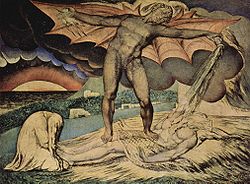 |
|||
| Job's Comforters | And when they lifted up their eyes afar off & knew him not they lifted up their voice & wept, and rent every Man his mantle & sprinkled dust upon their heads towards heaven |
||||
| Job's Despair | Let the Day perish wherin I was Born (Based upon ) |
||||
| The Vision of Eliphaz | Then a Spirit passed before my face the hair of my flesh stood up |
||||
| Job Rebuked by His Friends | The Just Upright Man is laughed to scorn |
 |
|||
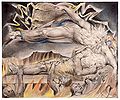 |
 |
Job's Evil Dreams | With Dreams upon my bed thou scarest me & affrightest me with Visions |
||
| The Wrath of Elihu | I am Young & ye are very Old wherefore I was afraid |
||||
| The Lord Answering Job out of the Whirlwind | Then the Lord answered Job out of the Whirlwind |
||||
| When the Morning Stars Sang Together | When the morning Stars sang together, & all the Sons of God shouted for joy |
||||
| Behemoth and Leviathan | Behold now Behemoth which I made with thee |
||||
| The Fall of Satan | Thou hast fulfilled the Judgment of the Wicked |
||||
| The Vision of Christ | I have heard thee with the hearing of the Ear but now my Eye seeth thee |
||||
| Job's Sacrifice | And my Servant Job shall pray for you |
||||
| Every one also gave him a piece of Money | Every one also gave him a piece of Money |
||||
| Job and His Daughters | There were not found Women as fair as the Daughters of Job in all the Land & their Father gave them Inheritance among their Brethren |
.jpg) |
|||
| Job and His Family Restored to Prosperity | So the Lord blessed the latter end of Job more than the beginning |

